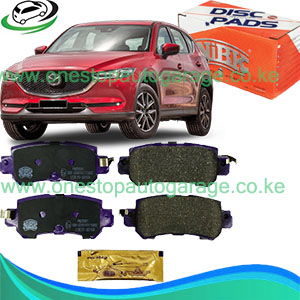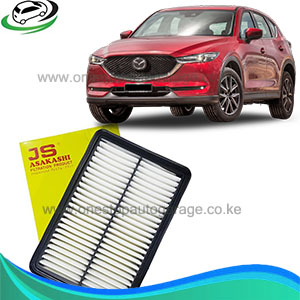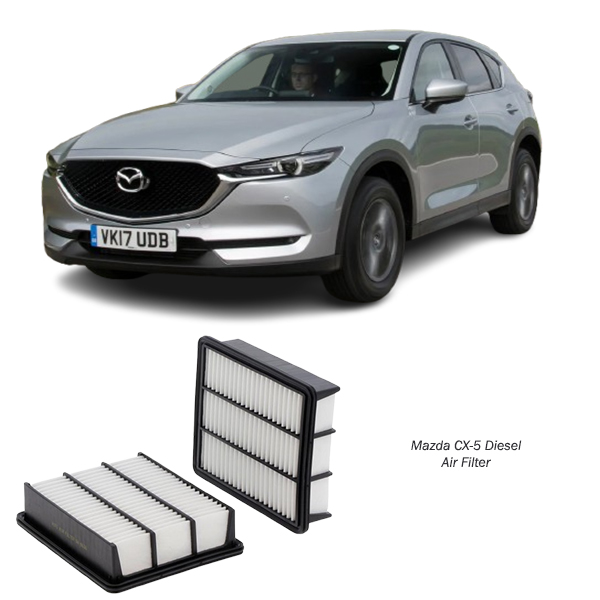-20%
Get Mazda CX-5 Diesel Air Filter PY8W-13-3A0 in Kenya
An air filter is a critical component in the internal combustion engine of a vehicle, playing a key role in ensuring optimal performance, fuel efficiency, and engine longevity. It is responsible for preventing contaminants such as dust, dirt, and debris from entering the engine, where they could cause significant damage. In this comprehensive guide, we will explore the construction, types, benefits, maintenance, and importance of air filters in detail.
1. The Function of an Air Filter
The air filter acts as a protective barrier for the engine by ensuring clean air reaches the combustion chamber. A balanced air-fuel mixture is vital for the efficient functioning of an engine, and the air filter helps achieve this by supplying uncontaminated air.
a) Key Functions
- Contaminant Removal: Filters out dirt, pollen, debris, and other airborne particles.
- Air Quality Improvement: Provides clean air for combustion, optimizing engine performance.
- Engine Protection: Prevents harmful particles from damaging internal engine components such as pistons and cylinders.
2. Construction of an Air Filter
Air filters are designed to be durable and efficient, capable of withstanding a wide range of environmental conditions while effectively trapping contaminants.
a) Key Components
- Filter Media: Made from paper, foam, or synthetic materials to trap particles of varying sizes.
- Frame: Typically constructed from plastic or metal to maintain the filter’s shape.
- Seals: Ensure a tight fit, preventing unfiltered air from bypassing the filter.
b) Types of Filter Media
- Paper: Cost-effective and widely used, suitable for most vehicles.
- Foam: Offers higher durability and is often used in off-road vehicles.
- Cotton or Synthetic: Provides superior filtration and is reusable after cleaning.
3. Types of Air Filters
Air filters come in various types, each tailored for specific vehicle needs and operating conditions.
a) Based on Design
- Panel Air Filters: Flat and rectangular, commonly used in passenger cars.
- Conical Air Filters: Cone-shaped, often found in high-performance vehicles.
- Cylindrical Air Filters: Cylinder-shaped, used in heavy-duty applications.
b) Based on Filtration Mechanism
- Dry Air Filters: Use a simple, dry media to trap contaminants.
- Oil-Bathed Filters: Utilize an oil-coated media for enhanced filtration, commonly found in older vehicles and off-road machinery.
- High-Efficiency Particulate Air (HEPA) Filters: Provide exceptional filtration, often used in advanced vehicles.
4. Benefits of Air Filters
Air filters offer a range of benefits, from protecting the engine to enhancing the overall driving experience.
a) Engine Protection
- Prevents abrasive particles from causing wear and tear on engine components.
- Reduces the likelihood of costly repairs caused by debris buildup.
b) Performance Optimization
- Ensures a clean air supply, allowing the engine to run smoothly and efficiently.
- Helps maintain the correct air-fuel ratio, which is crucial for combustion.
c) Improved Fuel Efficiency
- A clean air filter reduces engine strain, enhancing fuel economy.
- Dirty filters can reduce fuel efficiency by as much as 10%.
d) Environmental Benefits
- Clean air filters reduce harmful emissions by supporting efficient combustion.
- Helps meet environmental regulations and standards.
5. Maintenance of Air Filters
Proper maintenance of air filters is essential for sustaining engine performance and preventing issues.
a) Inspection
- Regularly check the air filter for dirt, debris, or damage.
- Hold the filter up to a light source; if light doesn’t pass through, it’s time for cleaning or replacement.
b) Cleaning
- Reusable Filters: Wash with water or a specialized cleaning solution and allow to dry completely before reinstallation.
- Compressed Air: For non-reusable filters, lightly blowing compressed air can extend their lifespan.
c) Replacement
- Replace air filters as recommended in the vehicle owner’s manual, typically every 12,000 to 15,000 miles, or sooner in dusty environments.
- Always use high-quality filters compatible with your vehicle.
6. Signs of a Dirty or Failing Air Filter
Knowing the symptoms of a clogged or failing air filter can prevent engine problems.
a) Reduced Performance
- Sluggish acceleration or loss of engine power.
- Difficulty maintaining speed on inclines.
b) Poor Fuel Efficiency
- Increased fuel consumption due to restricted airflow.
c) Black Smoke from the Exhaust
- Indicates incomplete combustion caused by an improper air-fuel mixture.
d) Unusual Engine Sounds
- Whistling or popping sounds may occur due to restricted airflow.
e) Check Engine Light
- A clogged air filter can trigger the check engine light in modern vehicles.
7. Replacement Process for Air Filters
Replacing an air filter is a simple process that requires minimal tools and time.
a) Tools Needed
- Screwdriver or wrench (depending on your vehicle).
- Replacement air filter.
b) Step-by-Step Instructions
- Locate the Air Filter Housing: Found near the engine intake, usually in a plastic box.
- Remove the Housing Cover: Unscrew or unclip the cover to access the filter.
- Take Out the Old Filter: Carefully remove it and note its orientation.
- Inspect the Housing: Check for debris and clean the housing if necessary.
- Install the New Filter: Place the new filter in the same orientation as the old one.
- Secure the Housing Cover: Tighten screws or clips to ensure a proper seal.
8. Troubleshooting Air Filter Issues
a) Improper Fit
- Ensure the filter matches your vehicle’s specifications to avoid air bypass.
b) Frequent Clogging
- Driving in dusty environments may require more frequent replacements.
c) Moisture Damage
- Ensure the filter housing is sealed properly to prevent water intrusion.
9. Cost Considerations and Quality Choices
a) Factors Influencing Cost
- Material: High-performance filters made of synthetic or cotton materials are more expensive.
- Brand: Reputable brands may cost more but offer better durability and efficiency.
- Vehicle Type: Filters for specialized or high-performance vehicles often carry a premium.
b) Choosing the Right Filter
- Refer to the owner’s manual for compatibility and specifications.
- Consider reusable filters for cost savings and environmental benefits.
10. Environmental Impact and Recycling
a) Eco-Friendly Options
- Reusable air filters reduce waste and are a more sustainable choice.
b) Recycling Old Filters
- Some manufacturers offer recycling programs for used filters.
- Dispose of filters responsibly at designated collection centers.
11. Conclusion
The air filter is an indispensable component of a vehicle’s engine system, ensuring clean air reaches the combustion chamber and preventing harmful particles from causing damage. Regular maintenance, timely replacements, and choosing the right air filter can significantly enhance engine performance, fuel efficiency, and longevity. By understanding the importance of air filters and following best practices, vehicle owners can ensure a smoother, safer, and more environmentally friendly driving experience.
Follow us on Facebook for more parts.



